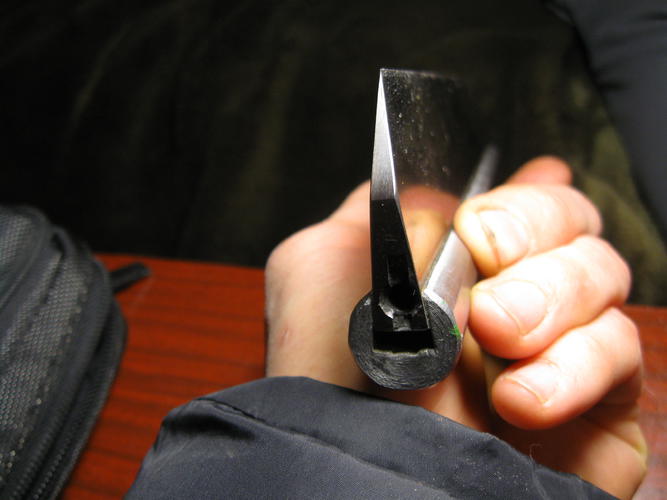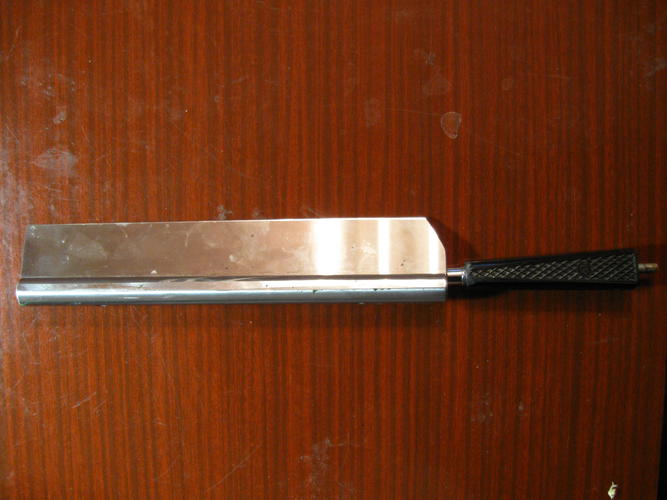Results 51 to 60 of 270
-
05-07-2015, 02:38 AM #51

With all respects, I would like to point out a few things.
In regards to raising the spine off the stone for the last few strokes. Lets call these last few strokes "the last 3 out of the 100" total (or 500, I don't care). That does work, at first. It will get you a shave, but the next time you hone your wedge, and you have to access the edge you will in the first 97 strokes need to hone off more steel out of necessary to get to that same last step of those last 3 again. Micro beveling is nothing new but for a razor that are normally laid flat on the stone it creates extra work down the road including resizing the spine thickness to keep the spine height to blade width proportion consistant.
I read that whole article by Benjamin Kingsbury, really nice find to have that pamphlet handy through google books. He talks about lifting the spine and how it might be necessary if 1) a tough beard is in need of a steeper angle edge, or 2) a spine that is too thin and out of proportion for the width of the blade. He suggests that these cases do occur but are "comparatively rare".
Kingsbury goes into detail on honing with the razor laid flat on the stone, he mentions nothing about how flat the stone is, or its need to be. I am assuming that in the 1700s and early 1800s a normal stone surface is concave and that this is why it is not necessarly to mention the flatness or concavity of a stone.
Now to the Frenchman J.J. Perret. If someone could actually translate his ideas of the hones configuration, I would appreaciate it. I would suggest off hand though that if he is using two similar hones and rubbing them together with a loose pumice grit inbetween the stones, it sounds like he is creating a concave stone on purpose. Two stones rubbed together with an alternate abrasive between them leaves neither stone flat.
Does he actually say that he is creating a flat stone by doing this? Also about his hollow ground razors, are they covered in this same paper and is he tying the new hollow ground profile razors to his shaping of the stones surfaces? Can you fill in some details?
AlexLast edited by alx; 05-07-2015 at 02:45 AM.
-
05-07-2015, 03:41 AM #52

My random thoughts.
If a razor is 200 years old and still in good shape, no spine wear etc. it has not been used. {Very much at least.}
If it had been used every day by a barber it would have been junk at least 150 years ago. Then tossed or remelted.
Therefore any surviving razor was probably owned by someone that didn't know how to sharpen it and got disappointed in its performance and threw it in a drawer for one of their heirs to find. They would rather have a beard than shave with that POS.
Fast forward 200 years and we find it. We wonder how in the heck did that guy do it when he didn't know how do it right himself.

-
05-07-2015, 04:29 AM #53

I don't really agree with that since I have a razor that I got from an older gentleman that he got in the 50's and used it atleast 5 days a week up until about 8yrs ago when his hands wouldn't allow him to use it anymore safely. He stated that he would only give it the occasional touch up on a barbers hone or a coticule and it has served him well for more than 50 yrs. When I received it there was maybe 1 mm worth of hone wear if that. If a razor is properly maintained and well cared I think you could probably go a generation with very little hone wear. Barbers on the other hand would have honed a razor more often from more frequent shaves, but even then I don't think it would have been all that significant without damage having to be honed out.
-
05-07-2015, 04:39 AM #54
-
The Following User Says Thank You to onimaru55 For This Useful Post:
Kees (05-07-2015)
-
05-07-2015, 06:17 PM #55Senior Member



- Join Date
- Apr 2008
- Location
- Essex, UK
- Posts
- 3,816
Thanked: 3164
I guess that we will have to agree to differ, Alex
You maintain that the old treatise did not mention that the hones were dished means that they were not lapped true, whereas I take the opposite view: Kingsbury not mentioning that the stones are lapped true means that they are lapped true.
I too have seen many dished hones - used for sharpening edges that were small in width, eg leather work tools, cobblers tools and for larger things like gouges which would also have a rounded slipstone for the inside of the blade, and of course left to posterity by those who did not have a clue about honing and those that did not know how to flatten them.
One last point from me, as this discussion has become quite boring with just ideas given as proof and no historic articles nor any empirical data backing it up.
The point I referred to is this - Charles Holzapfel's Turning and Mechanical Manipulation. The book is composed of various volumes, some completed around 1843 - 1850, but when Charles died it was up to his son to publish - he was a minor when his father died, so some of the volumes had to wait another 20 years to see the light of day.
Holzapfel talks about Kingsbury, but goes on to leave this sage advice"
"...Various kinds of whetstones are more or less used in sharpening razors, commonly in pieces measuring from eight to ten inches long, by one and a half to two inches broad, and great importance is deservedly attached to their being perfectly flat on the face, with which view they are occasionally rubbed on a large gritstone with water, but in use they are always supplied with oil and kept remarkably clean..."
In the absence of any proof to the contrary I exit this thread.
Regards,
NeilLast edited by Neil Miller; 05-07-2015 at 07:14 PM.
-
The Following 5 Users Say Thank You to Neil Miller For This Useful Post:
cudarunner (05-08-2015), JazzWillie (05-18-2015), MikeB52 (05-09-2015), onimaru55 (05-08-2015), SirStropalot (05-08-2015)
-
05-07-2015, 06:33 PM #56

Maybe something like this :


It has long brought to sharpen.
-
05-07-2015, 07:31 PM #57

Please re-read my post #42. Perret describes on page 8 how to get a hone entirely flat. He tells the reader to use pumice to flatten the hone and if necessary to eliminate any scratches left by the pumice by rubbing 2 razor hones together. No sandwiching a pumice between 2 razor hones.
Plus ça change, plus c'est la même chose. Jean-Baptiste Alphonse Karr.
-
05-07-2015, 10:40 PM #58

Kees
Thanks for the reminder to your post #42. Rubbing two stones of like nature can cancel each others shapes but at some point they take on the mirror or mimic the shape of the other, I am told. It is usually suggested that 3 stones used alternately will cancel each others foibles completely and you can get really close to true flat. Not alternate grit necessary as this tends to pool in the negetive low spots.
Thanks for your imput, greatly appreciated.
Alex
-
05-08-2015, 12:51 AM #59

Neil
I respect the research that you and Kees have done on this subject and I accept the findings that you have provided as authentic and pertinent to this conversation. There was obviously a movement and a need at the time to educate razor users to using flat stones and the flatter the better. The omission of any encouragement to create and use concave stones in those papers cited is obvious and relevant and is evidence that men of science saw the wisdom and practicability in using flat stones with their razors.
I am a user of flat stones, and I lap a lot, I also use a diamond plate to raise a slurry so this is a lapping step too. I think that all of the members here and razor users around the world are now benefiting from the principles set forth by those learned men who helped set the standards for generations to follow as we do now.
I lap my stones regularly because in using them they become concave through normal wear. If I didn't lap them they would become concave by default. Default concave as a direct result of normal use. All stones that are used for honing change shape, just as river rocks change shape over the years by abrasion with other rocks. We know that barbers in the early days did not have the beni of lapping plates as we do, and we know that rubbing 3 stones together as proven to be effective in flattening each of them if enough time is spent in doing so.
So in conclusion I would suggest that during the Industrial Revolution of the 1760 to 1840s, years that encompass the Golden Era of the heavy wedge razors, there was an avid movement to educate straight razor users in technique and to steer them towards the use of flat stones.
With all this said, and with your and others contributions, I think we have not proven anything. Maybe we should have listened to Glen in the first place:
I suspect that even if I offered a concave hone or two as a Pass Around one in Europe and one in the USA that no one would be interested because the concave hone theory cannot prove a historical quirk in time one way or the other.
I bow to the SRP status quo.
Alex Gilmore
-
05-08-2015, 02:05 AM #60


 426Likes
426Likes LinkBack URL
LinkBack URL About LinkBacks
About LinkBacks






 Reply With Quote
Reply With Quote



